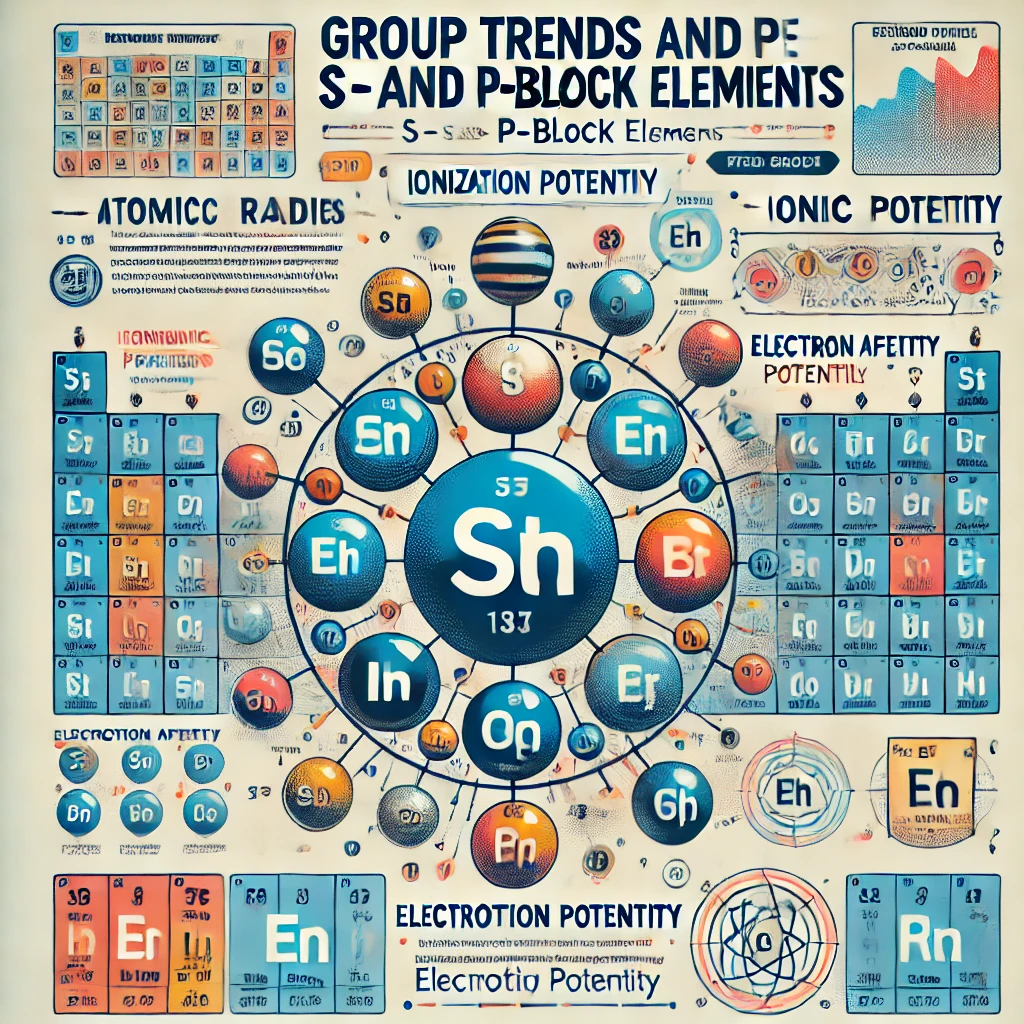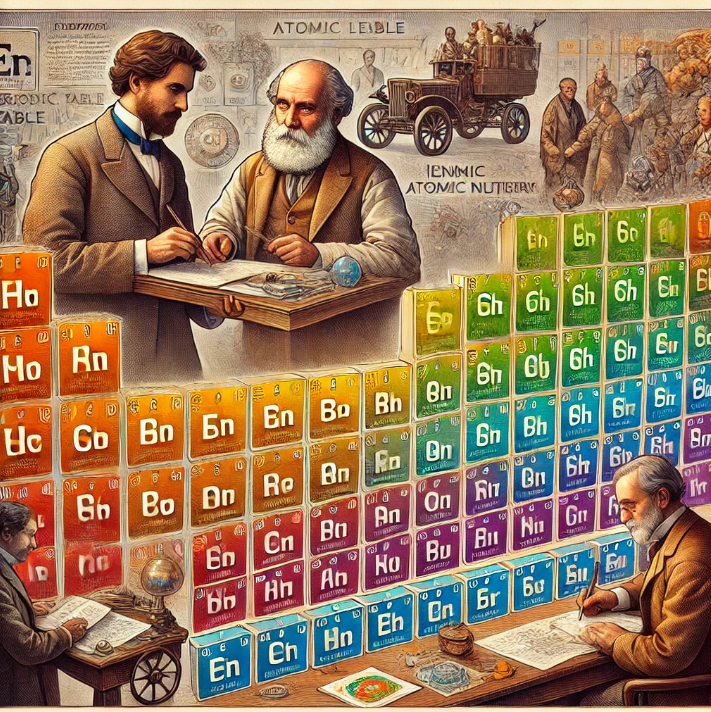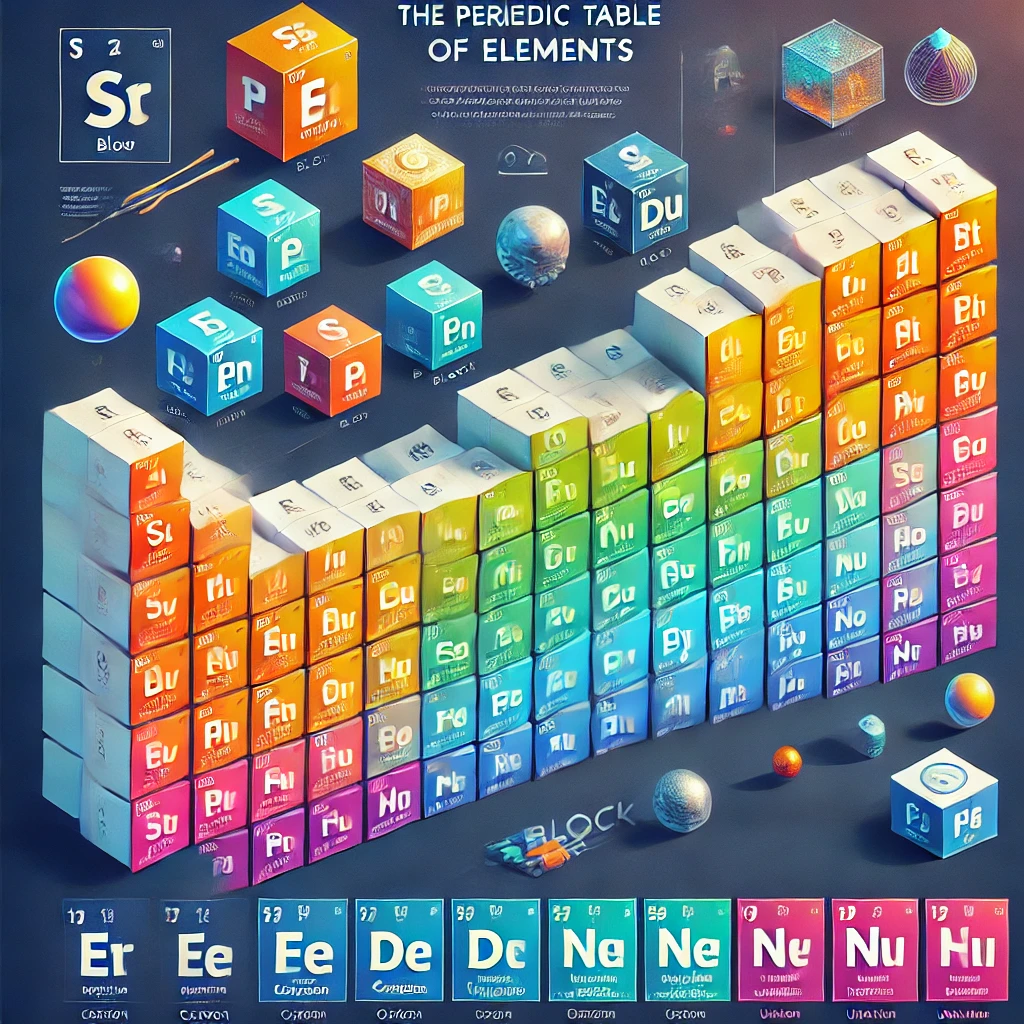The periodic table is a powerful tool for understanding the trends and properties of elements, especially in the s- and p-blocks. These elements exhibit predictable patterns in properties such as atomic radii, ionic radii, ionization potential, electron affinity, electronegativity, and redox potential. These trends are governed by factors such as effective nuclear charge, shielding effect, and electron-electron repulsion. Below is a comprehensive explanation of these properties, followed by reasoning-based questions to test your understanding.
1. Atomic Radii
- Definition: Atomic radius is the distance from the nucleus to the outermost electron shell.
- Trends:
- Across a Period (Left to Right): Atomic radii decrease due to an increase in effective nuclear charge, which pulls electrons closer to the nucleus.
- Down a Group (Top to Bottom): Atomic radii increase as new electron shells are added, increasing the distance between the nucleus and the outermost electrons.
- Reasoning:
- Across a period, the effective nuclear charge increases while shielding remains relatively constant, leading to a contraction in size.
- Down a group, the addition of electron shells outweighs the increase in nuclear charge, causing expansion.
2. Ionic Radii
- Definition: Ionic radius is the distance from the nucleus to the outermost electron in an ion.
- Trends:
- Cations: Smaller than their parent atoms because electrons are removed, reducing electron-electron repulsion and increasing effective nuclear charge.
- Anions: Larger than their parent atoms because electrons are added, increasing electron-electron repulsion.
- Across a Period: Ionic radii decrease for both cations and anions due to increasing effective nuclear charge.
- Down a Group: Ionic radii increase due to the addition of electron shells.
- Reasoning:
- The loss or gain of electrons alters the balance between effective nuclear charge and electron-electron repulsion, affecting ionic size.
3. Ionization Potential (Ionization Energy)
- Definition: Ionization energy is the energy required to remove an electron from a gaseous atom or ion.
- Trends:
- Across a Period: Ionization energy increases due to higher effective nuclear charge, making it harder to remove electrons.
- Down a Group: Ionization energy decreases because the outermost electrons are farther from the nucleus and experience more shielding.
- Reasoning:
- The increase in effective nuclear charge across a period strengthens the attraction between the nucleus and electrons. Down a group, shielding and distance reduce this attraction.
4. Electron Affinity
- Definition: Electron affinity is the energy change when an electron is added to a gaseous atom.
- Trends:
- Across a Period: Electron affinity generally increases (becomes more negative) due to higher effective nuclear charge, making the atom more likely to attract electrons.
- Down a Group: Electron affinity decreases (becomes less negative) because the added electron is farther from the nucleus and experiences more shielding.
- Reasoning:
- The ability to attract an electron is stronger when the effective nuclear charge is higher and the atomic radius is smaller.
5. Electronegativity
- Definition: Electronegativity is the tendency of an atom to attract shared electrons in a chemical bond.
- Trends:
- Across a Period: Electronegativity increases due to higher effective nuclear charge.
- Down a Group: Electronegativity decreases because the outermost electrons are farther from the nucleus and experience more shielding.
- Reasoning:
- Electronegativity depends on the balance between effective nuclear charge and atomic size.
6. Redox Potential
- Definition: Redox potential measures the tendency of an element to gain or lose electrons in a redox reaction.
- Trends:
- Across a Period: Metals on the left have low redox potentials (tend to lose electrons), while non-metals on the right have high redox potentials (tend to gain electrons).
- Down a Group: Redox potential decreases for metals (easier to lose electrons) and increases for non-metals (harder to gain electrons).
- Reasoning:
- Redox potential is influenced by ionization energy and electron affinity, which vary predictably across periods and groups.
Reasoning-Based Questions
- Why does atomic radius decrease across a period but increase down a group?
Answer: Across a period, the effective nuclear charge increases, pulling electrons closer to the nucleus. Down a group, new electron shells are added, increasing the distance between the nucleus and outermost electrons. - Explain why cations are smaller than their parent atoms, while anions are larger.
Answer: Cations lose electrons, reducing electron-electron repulsion and increasing effective nuclear charge, causing contraction. Anions gain electrons, increasing repulsion and causing expansion. - Why does ionization energy increase across a period but decrease down a group?
Answer: Across a period, effective nuclear charge increases, making it harder to remove electrons. Down a group, shielding and distance reduce the attraction between the nucleus and outermost electrons. - How does electron affinity change across a period and down a group? Provide a reason for this trend.
Answer: Electron affinity increases across a period due to higher effective nuclear charge, making atoms more likely to attract electrons. It decreases down a group because the added electron is farther from the nucleus and experiences more shielding. - Why is fluorine more electronegative than iodine?
Answer: Fluorine has a smaller atomic radius and higher effective nuclear charge, making it more effective at attracting shared electrons compared to iodine. - How does redox potential vary for metals and non-metals across a period?
Answer: Metals on the left have low redox potentials (tend to lose electrons), while non-metals on the right have high redox potentials (tend to gain electrons). - Why does the ionic radius of Na⁺ differ significantly from Cl⁻?
Answer: Na⁺ loses an electron, reducing its size due to increased effective nuclear charge. Cl⁻ gains an electron, increasing its size due to greater electron-electron repulsion. - What is the relationship between ionization energy and electron affinity?
Answer: Both ionization energy and electron affinity depend on effective nuclear charge. High ionization energy correlates with high electron affinity because both reflect strong nuclear attraction for electrons. - Why do alkali metals have low ionization energies compared to noble gases?
Answer: Alkali metals have a single electron in their outermost shell, which is far from the nucleus and experiences significant shielding. Noble gases have full valence shells with high effective nuclear charge, making electron removal difficult. - How does the redox potential of an element relate to its position in the periodic table?
Answer: Elements on the left (metals) have low redox potentials (tend to lose electrons), while elements on the right (non-metals) have high redox potentials (tend to gain electrons).


